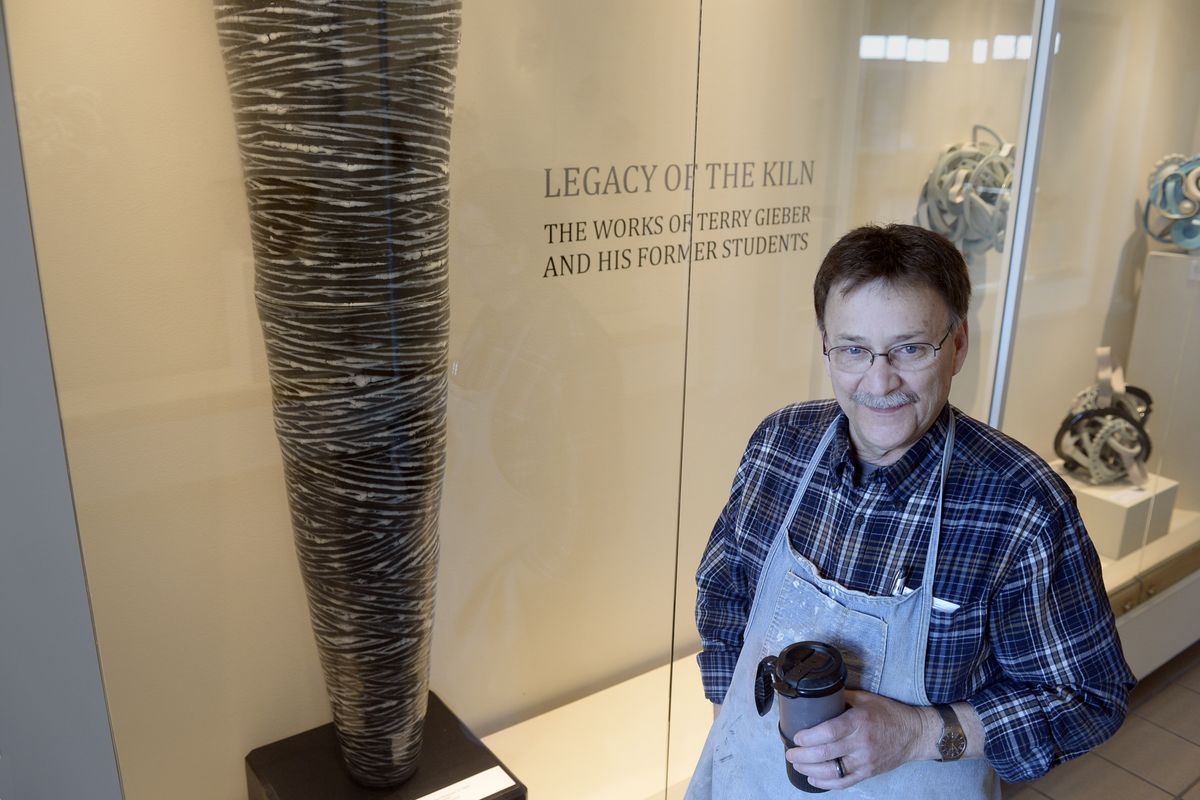Whirlwind of work
Exhibit puts spotlight on departing GU art professor, his former students

Terry Gieber, inventor of the tornado jar, likes some muscle in his weather, a show of strength.
But on his arrival in Eastern Washington some 30 years ago, the artist found the skies anemic – drizzle measured in weeks, a palette of gray.
Then one day, from the deck of his Liberty Lake apartment, he finally saw a lightning bolt hit Mica Peak. Expecting a booming-thunder follow-up, he heard a minor rumble.
That was it. He’d had it. He got in his car and left for Kansas, a quick road trip for a fix. In Colorado, he encountered tornado warnings.
“I pulled over and I stood like John Brown defiantly in the face of the oncoming tornado and said, ‘Bring it. I want some weather.’ ”
Gieber will return to Kansas again after he retires from Gonzaga in May, this time to stay. A show at the university’s Jundt Art Museum celebrates what he’ll leave behind: not only examples of his own work – infused with the forms and movement he observes in the landscape, including in his series of towering stoneware tornado jars – but a career spent teaching other artists to put shape to their own visions.
The exhibition pairs Gieber’s work with pieces by six of his former students.
Among them is Suzanne Lussier, an artist in Mendocino, Calif., who graduated from Gonzaga in 2000. Lussier said Gieber related to students – telling stories about his travels as he demonstrated techniques – in a way that made them feel they were part of a community of artists.
“He had an enthusiasm and excitement for what we were doing that would draw us in,” she said.
1997 graduate Sarah Beaty, another artist with work in the display, said Gieber was willing to take her on as a 17-year-old student, eager to enroll even before she’d finished high school.
The ceramics studio became her landing spot on campus, she said, and Gieber became a “stalwart and loyal mentor.” He gave students enough latitude to learn from their mistakes, Beaty said, but stepped in to help when needed.
Setting up her studio recently in Fort Yukon, Alaska, she called Gieber to help her troubleshoot a crisis with her kiln: “Seventeen years after his obligation to me ended, he’s still totally on my team.”
Despite his early frustration with the weather, Gieber’s own work reflects Inland Northwest and other non-Kansas landscapes, including his “Palouse pots” and “Palouse plates.”
He said he goes often to look at the Palouse – a more vertical version of Kansas, he said, with a more dramatic roll to the hills.
But the tornado jars were distinctly Midwest-inspired. Up to 10 feet tall and 1 ½ feet wide, some are decorated with a chaos of swirling lines, “layers of information” created by a process that took years to develop.
They show what Gieber remembers from living through real tornadoes. One day in South Dakota, he survived three of them by wrapping his arms and legs around the axle of a combine. While others might have squeezed their eyes shut, Gieber paid attention.
“When you experience that, there’s all kinds of things going on visually, with the winds and the objects flying past,” he said. “It was like ‘The Wizard of Oz.’ ”
He’s still building the Kansas home he’ll live in with his wife, Kim Gieber.
At 65, he has a lot of energy, he said. He wants to be able to use it in his own studio and toward other projects. Over the years Gieber has mounted dozens of exhibitions, including at the Smithsonian Institution and worked on tile restoration projects including one at the Cheney Cowles Museum’s Campbell House. He helped on water purification projects in West Africa. He’s served as artist-in-residence at the Archie Bray Foundation for the Ceramic Arts in Helena.
Kansas “desperately needs a liberal mind,” he said. And he’s happy to return to the landscape he grew up in.
The first time he visited in Kansas’ canyon country, he said, he used 26 rolls of film documenting trenches and rock formations and showed up three days late to where he was supposed to be.
Besides the dramatic parts of the landscape, he said, he likes its “constant renewal. It’s like art,” he said.
“My work is always in a state of change, always looking to solutions to the problems we create as art people,” he said. “You put down a mark. Then there has to be another mark. That’s all we do is create problems. I’ve always heard people say that artists are such great problem solvers. We create the problems in the first place.”